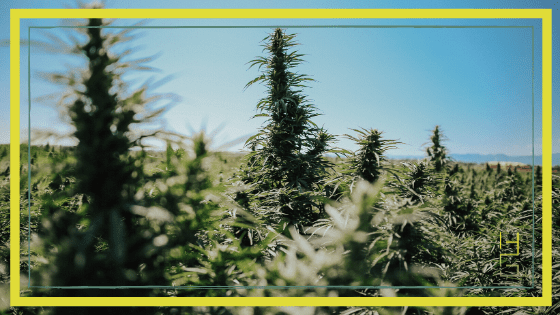The hemp plant contains over 100 unique chemical compounds known as cannabinoids. Recently, the cannabinoid known as “cannabigerol” or “CBG” has been gaining serious attention in the industry. However, scientific research on CBG is still in its infancy and the medical community is just beginning to understand potential applications for this new cannabinoid.
Since the cannabinoid CBD has gained so much popularity over the past 5 years, hemp growers, processors, and retailers have been looking for the next big thing. With such a massive market demand for CBD, it only makes sense to expand on the current cannabinoid marketplace. Yet, before the CBG space can realize its potential, there must be a good deal of cannabigerol research conducted.
One of the big challenges that might be slowing down cannabigerol research is that industrial plants typically yield only minute amounts of CBG (about 1% or less). That, however, is changing with the introduction of specialized hemp strains bred to produce more CBG. Strains like High Grade Hemp Seed’s Matterhorn CBG can produce up to 15% CBG, which may help give this under-studied cannabinoid the boost it needs.
Farmers who are considering planting hemp for CBG may wonder, “What are the benefits of CBG?” Though CBG research is still in its infancy, some scientific results have been very promising. High Grade Hemp Seed wanted to walk you through current CBD research and its potential uses for wellness.
CBG and the Endocannabinoid System
In order to understand how CBG might affect the human body, you must first understand the endocannabinoid system (ECS). The ECS is a newly-discovered neural network within the human body. Scientists theorize that the ECS functions to maintain the body’s systems in homeostasis, or a state of balance.
In discovering the ECS, researchers also discovered that the human body produces its own cannabinoids known as “endocannabinoids.” Scientists also realized that endocannabinoid deficiencies can develop into several medical problems. It is precisely this lack of endocannabinoids that can be rectified with the help of cannabinoids from the hemp plant – such as CBG and CBD.
Importantly, the ECS is thought to run throughout the human body, including the nervous system, digestive system, and immune system. The ECS is believed to help regulate:
- Mood
- Sleep
- Appetite
- Digestion
- Pain
- Memory
- Immune function
- Pleasure and reward system
The ESC extends throughout the body and so it follows that the effects of cannabinoids would vary according to the location of the receptors. There are two types of receptors: CB1 (in the brain and nervous system) and CB2 ( in the immune system). While other cannabinoids interact with one or the other, CBG appears to bind with both, potentially giving it the power to affect homeostasis in multiple systems.
If studies on the ECS are correct, imbalances in the endocannabinoid system can wreak havoc on your overall wellness. To this end, current CBG health research also implies that the cannabinoid could be extremely helpful in curbing many forms of endocannabinoid deficiencies.
1. CBG and Glaucoma
According to the Glaucoma Research Foundation, over three million Americans have glaucoma, a condition in which high ocular pressure damages the optic nerve. Left untreated, glaucoma can cause vision problems and, eventually, blindness.
The human eye is known to host many endocannabinoid receptors. A study published in 2008 found that cannabinoids, including CBG, may help to relieve pressure inside of the eye. This could make CBG an effective treatment for glaucoma. It will be interesting to see where cannabigerol research goes with glaucoma in the coming years.
2. CBG and Cancer
Early-stage research has already shown that CBD can inhibit the spread of breast, prostate, colon, and lung cancer cells. Though these studies were conducted on animals and in test tubes, the potential for CBD as a cancer treatment is exciting to say the least.
What about CBG and cancer? Unsurprisingly, little research has looked at how CBG may help fight cancer. One study published in the journal Carcinogenesis, however, did find that CBG might reduce the growth of cancer cells in rats with colon cancer. This early-stage research is promising and should be continued. CBG proponents would love to see institutions put more money into researching the cancer-fighting properties of CBG.
3. CBG and MRSA
Methicillin-resistant Staphylococcus aureus (MRSA) has become the bane of hospitals, health clinics, and nursing homes. This dangerous bacterial infection is infamous for its ability to resist most antibiotic treatments. In 2017, nearly 120,000 people in the U.S. contracted MRSA, and almost 20,000 died. The hunt is on for an effective MRSA treatment.
Medical researchers are currently looking at CBG as an antibiotic treatment for MRSA. To illustrate, McMaster University conducted a study on the effectiveness of CBD on MRSA. They concluded, “CBG had antibacterial activity against drug-resistant MRSA. It prevented the ability of that bacteria to form biofilms, which are communities of microorganisms that attach to each other and to surfaces.”
It will be interesting to see how CBG health research evolves in the future with treating MRSA.
4. CBG and Huntington’s Disease
Huntington’s disease is a rare and cruel genetic disorder that progressively breaks down nerve cells in the brain. Individuals with the disorder usually start to exhibit symptoms in their 30s or 40s and face a long, slow mental and physical decline.
While there is no current cure for Huntington’s disease, a fascinating study on mice with Huntington’s found that CBG was “extremely active as a neuroprotectant.” CBG’s neuroprotective properties could make it a potential treatment for a variety of neurodegenerative disorders besides just Huntington’s disease.
5. CBG and Inflammatory Bowel Disease
Endocannabinoid receptors are active in the digestive system, so perhaps it shouldn’t be surprising that cannabigerol benefits could extend to certain diseases linked to the gut. Inflammatory bowel disease (IBD) is actually a group of diseases that attack the colon and small intestine. The most well-known IBDs are Crohn’s disease and ulcerative colitis.
In a study on mice, CBG seemed to reduce the inflammation that is a hallmark of IBD, which could go a long way toward helping alleviate the unpleasant symptoms of IBD. The authors of the study suggest that CBG be considered for clinical experimentation in IBD patients.
6. CBG as an Appetite Stimulant
A study on rats in the journal Psychopharmacology found that CBG was a reliable appetite stimulant. The rats in the study gobbled up more than twice their normal food intake and ate extra meals when taking CBG. The appetite-boosting properties of CBG could be helpful for patients struggling to eat and maintain weight, such as individuals with cancer or HIV.
Appetite stimulation has long been a popular medical application of cannabinoids. The most widely known cannabinoid “tetrahydrocannabinol” (THC) was originally used to help with appetite stimulation for both cancer and AIDS patients. One might argue that THC is so effective in this application that it led to the eventual legalization of medical cannabis in states like California and Colorado.
7. CBG and Bladder Dysfunction
Involuntary bladder contractions are a condition no one wants to experience. A mouse trial of five different cannabinoids found that CBG showed the greatest impact on reducing bladder contractions. The authors of the study also found that CBG reduced bladder contractions in the human bladder.
More CBG Health Research is Needed
While the CBG benefits highlighted in this article are highly promising, it’s important to reiterate that these are all early-stage studies. It should not be assumed that just because CBG showed a certain impact on animals or cell cultures that it will have the same health properties in humans. Even more, we want to stress the fact that CBG products should only be purchased from highly reputable sources.
There is no doubt that CBG holds great promise for the medical community. However, to realize the latent potential of CBG, doctors and researchers must conduct well-funded human trials. As the CBG industry continues to gain momentum, we hope that the medical community will give this little-known cannabinoid the attention it requires.


